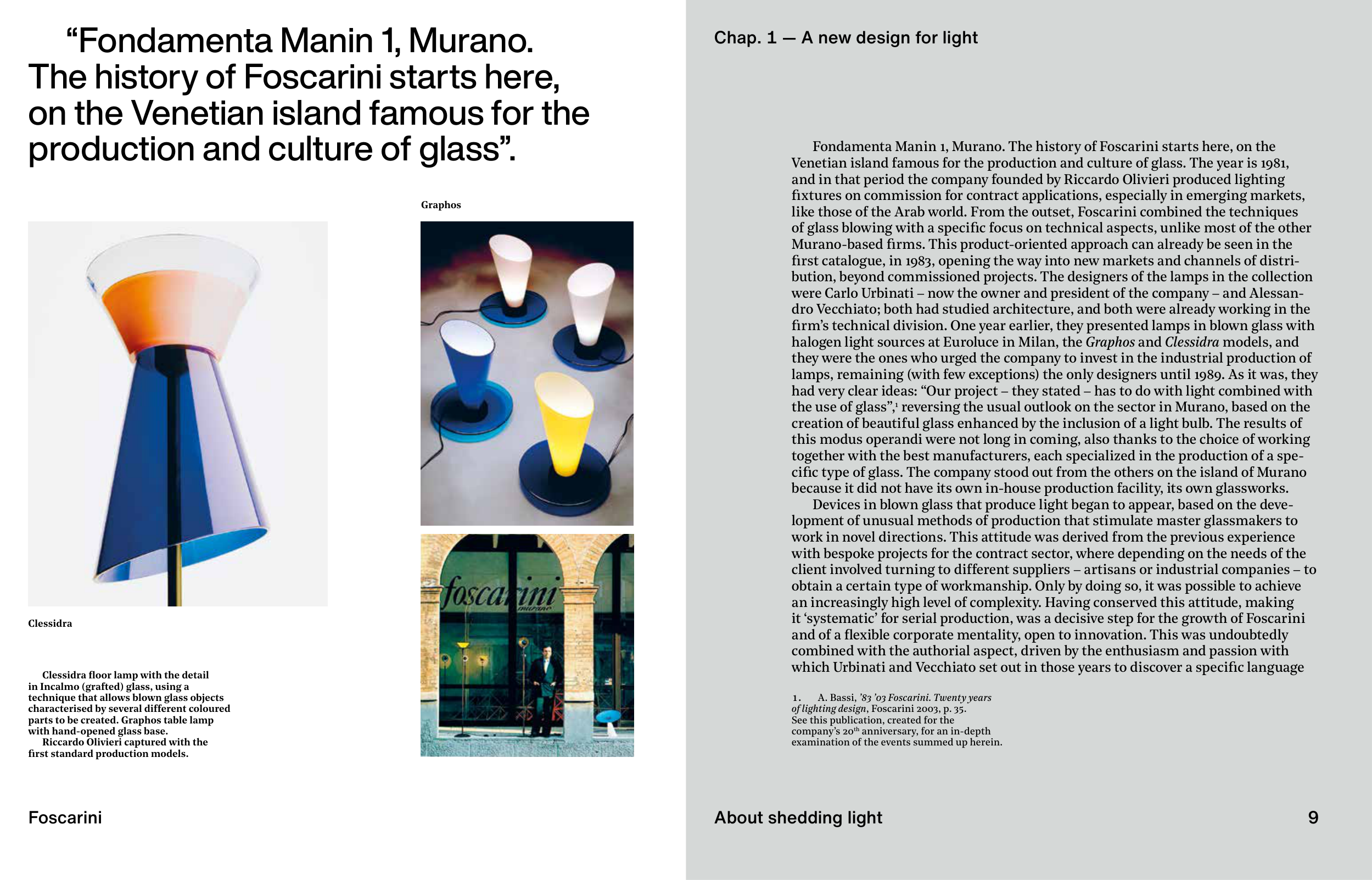Cap. 1 — 1983 /2003: Un nuovo design della luce
9
Foscarini
About shedding light
Chap. 1 — A new design for light
Fondamenta Manin 1, Murano. The history of Foscarini starts here, on the
Venetian island famous for the production and culture of glass. The year is 1981,
and in that period the company founded by Riccardo Olivieri produced lighting
fi xtures on commission for contract applications, especially in emerging markets,
like those of the Arab world. From the outset, Foscarini combined the techniques
of glass blowing with a specifi c focus on technical aspects, unlike most of the other
Murano-based fi rms. This product-oriented approach can already be seen in the
fi rst catalogue, in 1983, opening the way into new markets and channels of distri-
bution, beyond commissioned projects. The designers of the lamps in the collection
were Carlo Urbinati – now the owner and president of the company – and Alessan-
dro Vecchiato; both had studied architecture, and both were already working in the
fi rm’s technical division. One year earlier, they presented lamps in blown glass with
halogen light sources at Euroluce in Milan, the Graphos and Clessidra models, and
they were the ones who urged the company to invest in the industrial production of
lamps, remaining (with few exceptions) the only designers until 1989. As it was, they
had very clear ideas: “Our project – they stated – has to do with light combined with
the use of glass”,1 reversing the usual outlook on the sector in Murano, based on the
creation of beautiful glass enhanced by the inclusion of a light bulb. The results of
this modus operandi were not long in coming, also thanks to the choice of working
together with the best manufacturers, each specialized in the production of a spe-
cifi c type of glass. The company stood out from the others on the island of Murano
because it did not have its own in-house production facility, its own glassworks.
Devices in blown glass that produce light began to appear, based on the deve-
lopment of unusual methods of production that stimulate master glassmakers to
work in novel directions. This attitude was derived from the previous experience
with bespoke projects for the contract sector, where depending on the needs of the
client involved turning to different suppliers – artisans or industrial companies – to
obtain a certain type of workmanship. Only by doing so, it was possible to achieve
an increasingly high level of complexity. Having conserved this attitude, making
it ‘systematic’ for serial production, was a decisive step for the growth of Foscarini
and of a fl exible corporate mentality, open to innovation. This was undoubtedly
combined with the authorial aspect, driven by the enthusiasm and passion with
which Urbinati and Vecchiato set out in those years to discover a specifi c language
1.
A. Bassi, ’83 ’03 Foscarini. Twenty years
of lighting design, Foscarini 2003, p. 35.
See this publication, created for the
company’s 20th anniversary, for an in-depth
examination of the events summed up herein.
9
Clessidra
“Fondamenta Manin 1, Murano.
The history of Foscarini starts here,
on the Venetian island famous for the
production and culture of glass”.
Clessidra fl oor lamp with the detail
in Incalmo (grafted) glass, using a
technique that allows blown glass objects
characterised by several different coloured
parts to be created. Graphos table lamp
with hand-opened glass base.
Riccardo Olivieri captured with the
fi rst standard production models.
Graphos


